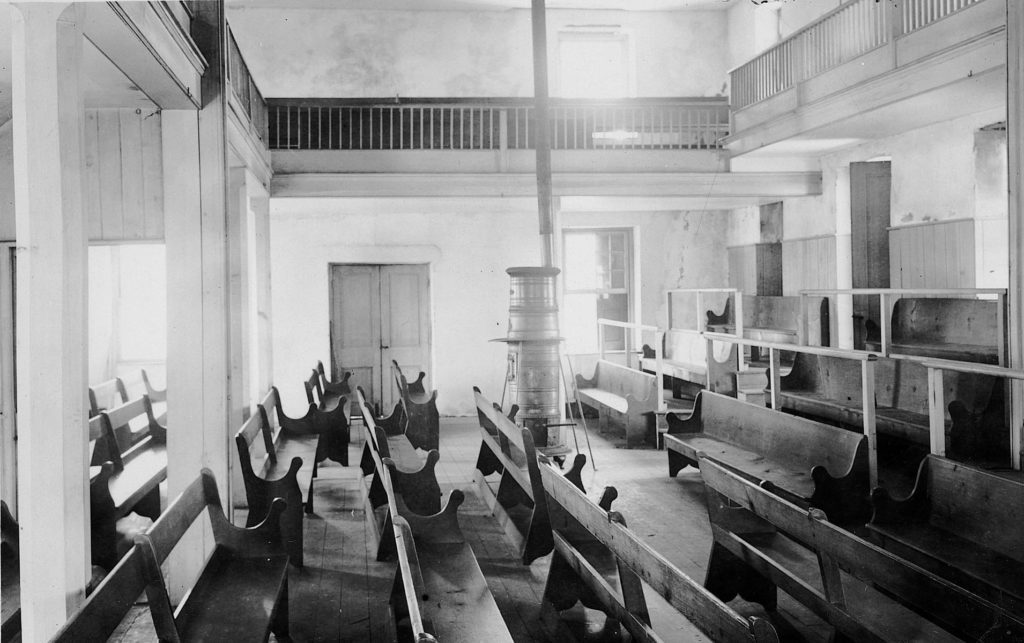
The Quakers
From those earliest days, the Quakers were a presence in the village.
1733
In 1733 Amos and Mary Janney, members of the Society of Friends (Quakers), traveled south from Bucks County, Pennsylvania, to the wilds of northern Virginia in search of open land and opportunity. They purchased 400 promising acres on the south fork of Catoctin Creek. A surveyor for Thomas Fairfax, 6th Lord Fairfax of Cameron, as well as a farmer and entrepreneur, Amos tapped the waterpower of the creek by building a grist and sawmill on its banks by the early 1740s. Most of the newcomers to the area were grain farmers like the Janneys, assuring the success of the mill. The little settlement that grew up around it came to be known as “Janney’s Mill.”
1741
As other Quakers from Pennsylvania and New Jersey followed the Janneys south, an early priority was a church or “meetinghouse.” In 1741 a log meetinghouse was built on Amos’s land. In 1755 his son Mahlon deeded ten acres on the site for a cemetery and school as well—the Quakers were very serious about education. The meetinghouse was named Fairfax because Loudoun was then part of Fairfax County. From those earliest days, until the meeting was “laid down” in 1929, the Quakers were a presence in the village. The meetinghouse, a private residence since 1939, still stands at 15510 Loyalty Road.
Among the first to join the Janneys in Virginia was Mary’s sister Jane and her husband Francis Hague. Hague bought 303 acres adjoining Janney’s land and built a stone cottage for his large family. That cottage still stands today on a ridge above Bond Street. Another Janney relative, cousin John Hough, quickly became the largest resident landowner in what is now Loudoun County. He and Hague both played important roles in the early history of the county. They were two of the original trustees of Leesburg and served as the county’s first flour inspectors.
1747
Amos Janney died in 1747, leaving his estate to his 16-year-old son Mahlon. Within a few years young Mahlon replaced the original log mill with a new two-story structure of wood and stone. This second mill was erected on the site of the present brick mill. The county began to build and improve local roads to facilitate the movement of goods to and from Janney’s Mill and, by the time Francis Hague died in 1780, the tiny village had begun to grow rapidly. Amos’s cousin Joseph Janney bought 12 acres from Hague’s estate and promptly laid out 15 lots on the south side of Main Street from the mill almost to the site of the present post office. Shops and dwellings soon followed, and sometime in the 1790s the growing village was renamed “Waterford.”
1800
In 1800 Mahlon Janney extended Main Street up the “Big Hill” by subdividing his property there into an additional 17 lots. And when Mahlon died in 1812, his executors divided his land between Second and High Streets into 64 more parcels.
Through the end of the 18th century, Waterford and its fertile hinterland continued to attract Quakers from Pennsylvania. And, increasingly, Scotch-Irish Presbyterians and German Lutherans, also from Pennsylvania, followed the Quakers. Baptists and Methodists came, too, adding to the lively social and ethnic mix. Besides their heritage and religious beliefs, these people brought their crafts and skills with them. Waterford became a bustling commercial town, supporting and serving a prosperous quarter of rural Loudoun County. By 1762 the ethnic mix included African Americans, some of them slaves, but others, especially after the turn of the century, free blacks—a relative rarity elsewhere in Virginia. By 1830, African Americans headed a fourth of Waterford’s free households; many of them owned their own homes.